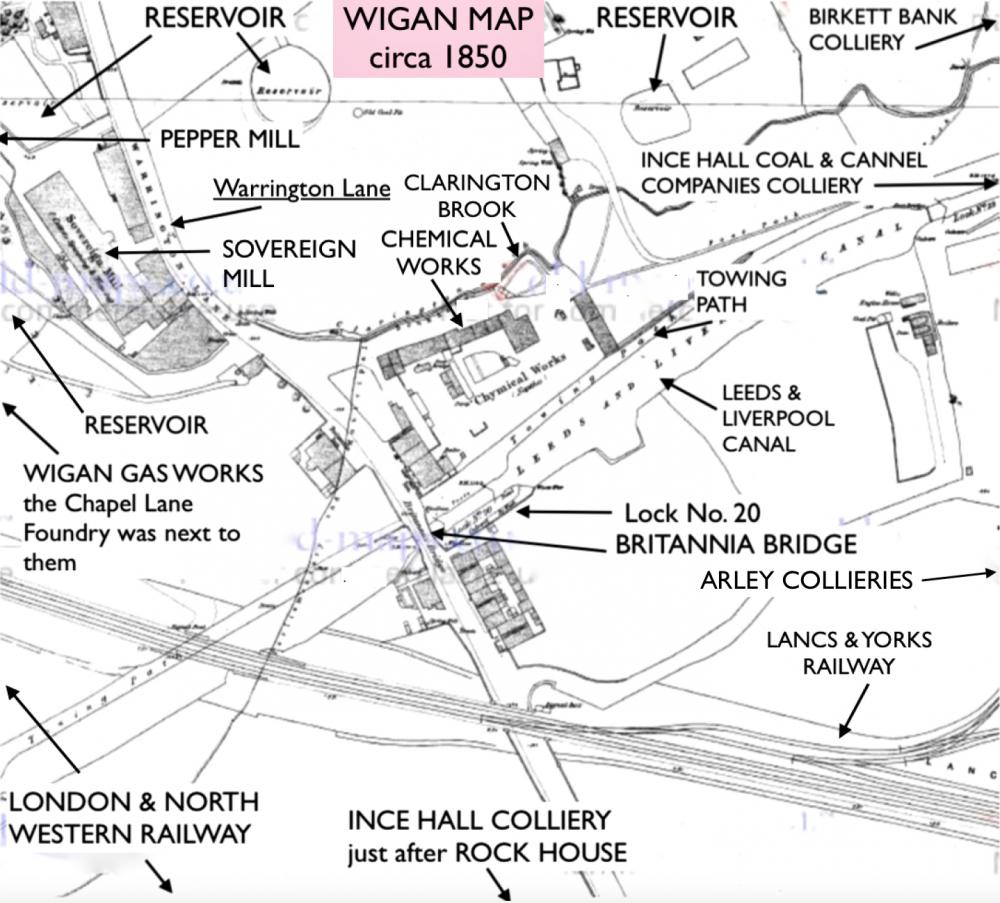Wigan Album
Map of Wigan and Ince-in-Makerfield 1850
5 Comments
Photo: Ben
Item #: 30246
I suppose it can be compared to an early kind of Industrial Estate on a grand scale. To the west was Chapel Lane, to the north was a partly built Hardybutts and Birkett Bank. I presume housing developments in this district would develop later when roads such as Darlington Street East and others roads were built.
Apparently, following a short-lived building boom in the early fifties (1850’s), house building fell dramatically not to recover until the mid-seventies (1870’s), also mirrored in Manchester, the centre of the cotton industry.
Structural economic problems can be traced back to the early 1830’s with the painful decline of the handloom weaving industry but the 1860’s crisis was directly attributable to the cotton famine caused by the American Civil War which had a drastic effect on Wigan's mills because of their complete dependence on short-fibre American cottons:
Housing in Wigan had a notorious reputation according to reports - Despite its inherently well-drained site, Wigan was, at the time of this map, in mid 19th century, considered to be one of the unhealthiest towns in the country and certainly far worse than most other towns of comparable size in Lancashire: the death rate in 1851 of 36 per 1,000 compared badly with 27 per 1,000 in the North West generally.
However, because of successful lobbying of both local ratepayers and Westminster by the Wigan Working Man's Association, a group supported by the local clergy, a somewhat reluctant borough council found itself having to operate the Public Health Act of 1848.
The main effects were very limited: the death rate between 1866 and 1870 averaged 32.7 per 1,000. (The population of Wigan in 1861 was around 37,000) Bye-laws relating to privy construction were generally disregarded; the water supply and sewerage systems were only very slowly improved and cellar dwellings, supposedly banned, often remained.
Most of these statements were taken from an article on 19th century housing in Wigan and St Helens by John T Jackson B.A., Ph.D.
Jackson concludes, “In Wigan there is some evidence that during the 'golden age' of handloom weaving, weavers clubbed together to build their own houses but efforts in this direction were short-lived as the building club principle was quickly adopted by larger capitalist interests responsible for some of Wigan's worst housing.
The demise of handloom weaving, the absence of other skilled but better-paid workers and the influx of large numbers of casual Irish labourers in the 1830’s and 1840’s further ensured a deterioration of housing conditions during the first half of the century.
The final note on nineteenth-century housing in Wigan, he says, must be a pessimistic one. One that sounds the general failure of early building clubs and local authorities alike in providing any marked improvement in working-class housing standards.
Even now this area (which is only a tiny part of Wigan/Ince and Darlington St wouldn't have been on it at that scale) has relatively few houses - Sovereign Road houses have gone and there are only a few other streets.
My maternal great grandmother lived all her married life in Wigan from 1873 - she gave birth to 15 children but only 5 lived to adulthood, the other 10 all died as infants. They either did not reach their first birthday or were one year of age when they died, except for one who passed away aged 4. No doubt her family "contributed" to those awful survival rates in Wigan at the time. She died in 1908 aged 54.
The death rate per 1,000 in the UK is presently 9 per 1,000 which is by no means the best in the world, however, a considerable improvement on the 30+ per thousand as above.
Quite right eric, very few houses were developed immediately west of Britannia Bridge, railway lines, mills, gas works etc., were all in the way but if you took a circular line from say Chapel Lane, to Hardybutts to Rose Bridge, Higher and Lower Ince and Westwood then in 1850 precious few houses were in existence at the time of this map. However, in the next 50 to 60 years thousands of houses were built within this otherwise empty area, providing homes for thousands of Wiganers of whom I was one. It wasn’t practical to show all this area in the posting.
Can anyone tell me, was there ever a manor house on Rose Hill in Bryn? I'm trying to solve a family mystery, and that's where it's said to have taken place.